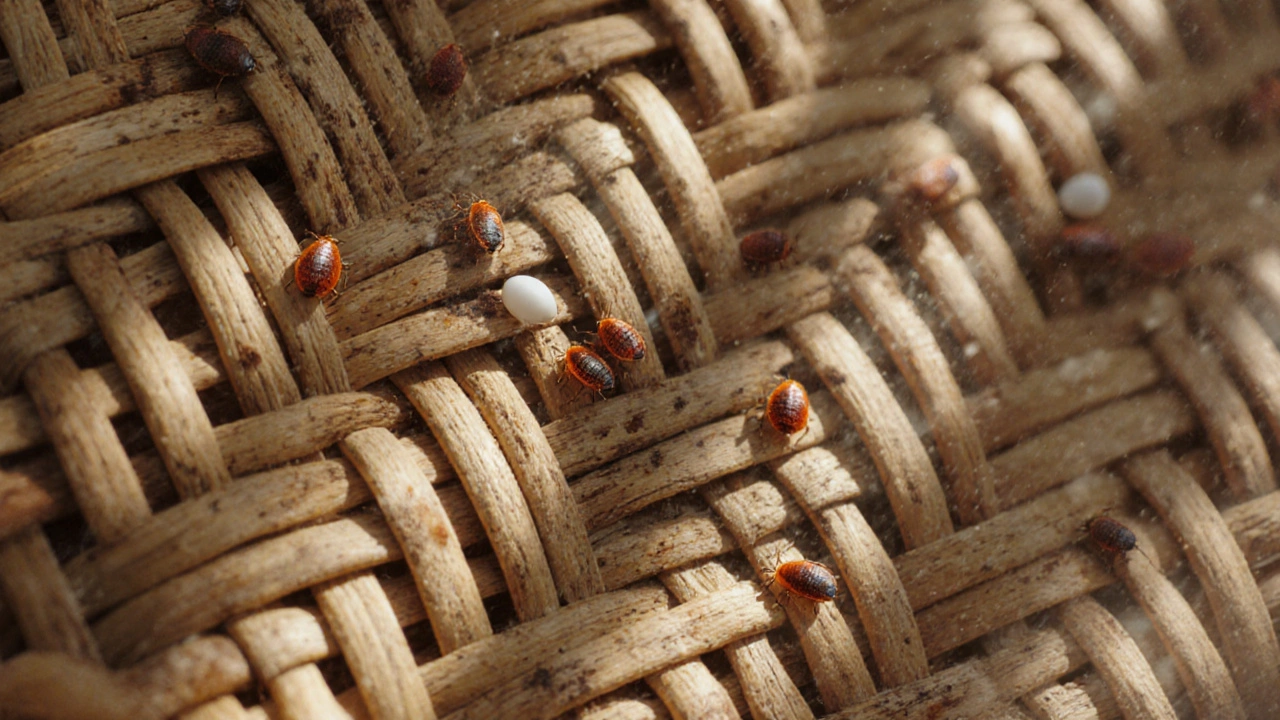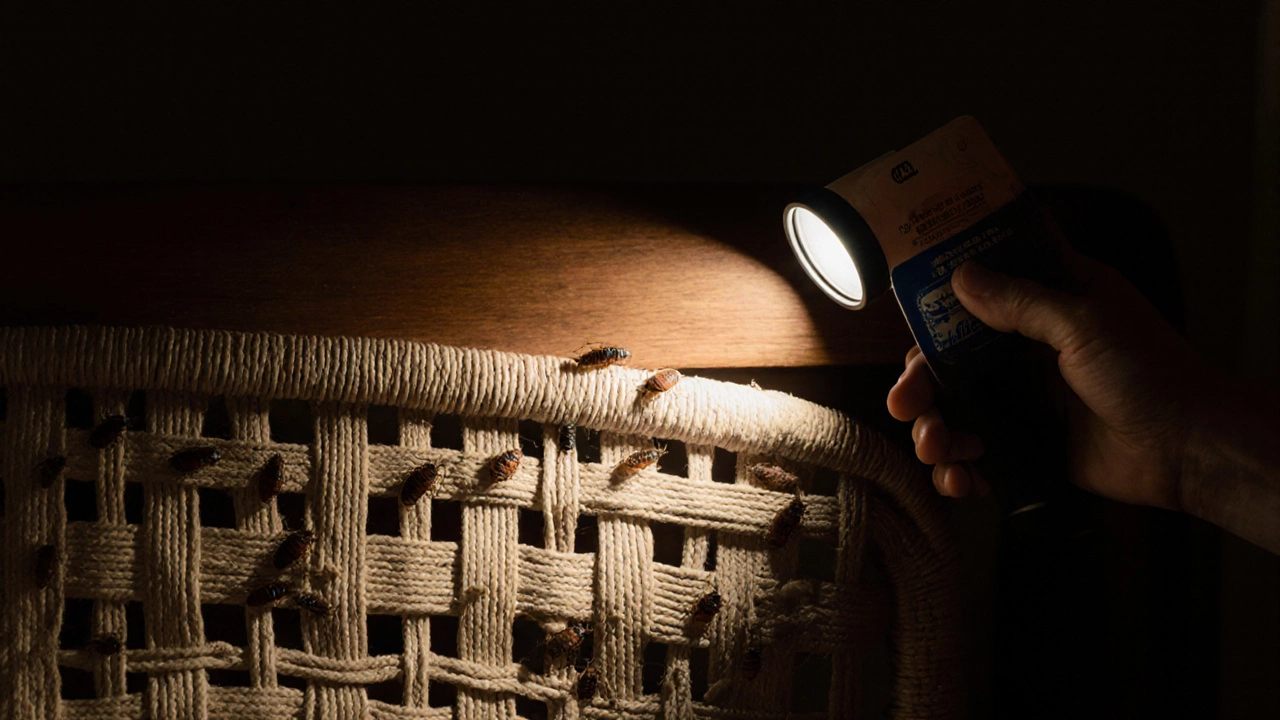
Bed Bug Identification Tool
Check for Bed Bugs in Your Wicker Furniture
Answer these questions to see if your wicker furniture might have bed bugs. This tool is based on professional inspection techniques and will help you determine your next steps.
Bed bugs don’t care if your furniture is made of wood, metal, or woven reed-they only care about one thing: access to blood and a place to hide. So when you spot a wicker chair on your porch or a vintage wicker basket in your bedroom, it’s natural to wonder: can bed bugs live in wicker furniture? The answer isn’t simple yes or no. It’s more like: yes, and they’re better at hiding in it than you think.
Why Wicker Is a Perfect Hideout
Wicker furniture isn’t just decorative. It’s full of cracks, gaps, seams, and woven nooks that bed bugs love. These pests are flat, about the size of an apple seed, and can squeeze into spaces as thin as a credit card. Wicker’s natural texture gives them endless crevices to crawl into and lay eggs. Unlike smooth surfaces like glass or plastic, wicker offers texture, warmth, and protection-all things bed bugs need to survive.One study from the University of Florida found that bed bugs preferred woven materials over smooth surfaces when given a choice. They settled into the tight spaces between reeds, under woven seams, and even inside the stuffing beneath the wicker weave. This isn’t just theory. Homeowners in Wellington and Auckland have reported finding live bed bugs inside wicker baskets used for storage, wicker headboards, and even wicker patio chairs left near bedrooms.
How Bed Bugs Get Into Wicker Furniture
You don’t need to buy infested wicker to get bed bugs in it. They’re hitchhikers. They travel on clothes, bags, secondhand items, or even on visitors. If someone with bed bugs sits on your wicker couch after a party, the bugs can drop off and hide in the weave. Same thing if you bring home a used wicker chair from a thrift store or garage sale.Bed bugs don’t fly or jump. They walk. And they’re patient. They can survive for over a year without feeding. That means a wicker piece stored in a garage or shed for months could still be carrying a hidden colony. Cold weather doesn’t kill them-unless it’s below -20°C for days. In New Zealand’s mild winters, they’re perfectly happy staying put.
Where to Look for Bed Bugs in Wicker
If you suspect bed bugs in your wicker furniture, don’t just glance at the surface. You need to dig deeper-literally. Here’s where to check:- Where the weave meets the frame-this is the most common hiding spot. Bugs nest where the reeds are tightly woven around the wooden or metal frame.
- Under cushions or padding-even if the wicker looks clean, bugs can hide underneath the fabric or foam.
- Inside hollow arms or legs-some wicker furniture has hollow supports. These are perfect for colonies.
- Cracks in the base or joints-look for dark, rust-colored stains (bed bug feces) or tiny white eggs stuck to the weave.
- Behind decorative trim or tassels-if your wicker piece has added fabric or fringe, bugs love hiding behind it.
Use a flashlight and a credit card or stiff brush to gently pry apart woven sections. Look for live bugs (reddish-brown, oval-shaped), shed skins, or dark specks that smear when wiped with a damp cloth.

Can You Get Rid of Bed Bugs in Wicker?
Yes-but it’s harder than cleaning a mattress or box spring. You can’t just throw wicker in the washing machine. Here’s what actually works:- Vacuum thoroughly-use a crevice tool to suck out bugs and eggs from every seam. Immediately seal the vacuum bag in a plastic bag and toss it outside.
- Steam clean-bed bugs die at 46°C. A steam cleaner with a narrow nozzle can kill bugs and eggs deep in the weave. Hold the steam on each spot for at least 10 seconds. Do this in a well-ventilated area-wicker can warp if it gets too wet.
- Heat treatment-if you have a small piece, like a wicker chair, put it in a black plastic bag and leave it in direct sunlight on a hot day (over 45°C). Leave it for 4-6 hours. This works best in summer.
- Use insecticides labeled for wicker-not all sprays are safe for porous materials. Look for products with pyrethroids or desiccants like diatomaceous earth. Spray lightly into cracks. Don’t soak it.
- Leave it alone for 6-12 months-if you can’t treat it properly, seal the piece in plastic wrap and store it away. Bed bugs starve without a blood meal. This is a last-resort option.
Don’t try bleach, alcohol, or essential oils. They might smell nice, but they won’t kill eggs or hidden bugs. And never burn wicker furniture-it’s dangerous and won’t solve the problem.
When to Replace Wicker Furniture
Sometimes, the best move is to toss it. If the wicker is old, cracked, or heavily stained, it’s probably too damaged to treat effectively. If you’ve tried steam, vacuuming, and heat-and you’re still seeing bugs after two weeks-you’re fighting a losing battle.Replace it with something less hospitable: metal, solid wood, or plastic. Avoid upholstered wicker. If you love the look, choose wicker with a smooth, sealed finish instead of loose weave. Some modern wicker furniture is coated with a protective layer that makes it harder for bugs to hide.

Preventing Bed Bugs in Wicker Furniture
Prevention is easier than elimination. Here’s how to keep bed bugs out:- Don’t bring home used wicker-unless you’re willing to inspect it under a magnifying glass and treat it before bringing it inside.
- Keep wicker away from beds-don’t place wicker chairs or baskets right next to your bed. Bed bugs travel about 1-2 meters per night. Distance matters.
- Check after travel-if you’ve stayed in a hotel or visited someone with an infestation, inspect your bags and wicker items before bringing them home.
- Use protective covers-if you have wicker headboards or seating near sleeping areas, cover them with smooth, tightly woven fabric. Bed bugs can’t grip it easily.
- Inspect seasonally-every spring and fall, take a flashlight and check all your wicker pieces. Early detection saves money and stress.
What About Outdoor Wicker Furniture?
Outdoor wicker doesn’t automatically mean safe. If it’s stored on a porch, balcony, or near a door, bed bugs can still get to it. People often leave outdoor furniture close to bedrooms-especially in apartments or townhouses. Bugs crawl in from inside, then hide in the weave during the day. Rain and sun won’t kill them. They just wait.One homeowner in Dunedin found bed bugs in her outdoor wicker set after her nephew visited with infested luggage. The bugs had crawled from the house, across the deck, and into the chair. She didn’t notice until she started getting bites at night.
So yes-outdoor wicker can carry bed bugs. Keep it at least 2 meters from entry points. Clean it regularly. And never let it double as indoor seating unless you’re sure it’s clean.
Final Verdict
Can bed bugs live in wicker furniture? Absolutely. Not because wicker is dirty-it’s just the perfect hiding spot. The weave gives them cover. The gaps give them space. And the warmth from nearby rooms gives them comfort.But here’s the good news: you can control it. You don’t need to throw out every piece of wicker in your home. You just need to know where to look, how to treat it, and how to prevent it from coming back. Most people who find bed bugs in wicker panic. But with the right steps, you can reclaim your space without spending thousands on exterminators.
Check your wicker. Clean it. Watch it. And if you’re unsure, get a professional inspection. Bed bugs don’t go away on their own. But they do go away when you know what you’re doing.
Can bed bugs live in outdoor wicker furniture?
Yes. Outdoor wicker furniture can host bed bugs if it’s stored near entry points like doors or windows, or if people bring infested items outside. Bed bugs don’t care if furniture is indoors or outdoors-they only need warmth, darkness, and access to hosts. Rain and sun won’t kill them, and they can survive for months without feeding.
Does steam cleaning kill bed bugs in wicker?
Yes, steam cleaning is one of the most effective methods. Bed bugs die at temperatures above 46°C. A handheld steam cleaner with a narrow nozzle can penetrate the weave and kill bugs and eggs on contact. Hold the steam on each area for at least 10 seconds. Be careful not to soak the wicker, as excess moisture can cause warping or mold.
Can you use insecticide spray on wicker furniture?
Yes, but only use sprays labeled for porous surfaces and bed bugs. Look for products with pyrethroids or desiccants like diatomaceous earth. Spray lightly into cracks and seams. Avoid soaking the furniture-too much liquid can damage the weave and create mold. Always follow the label instructions and ventilate the area after use.
How do I know if my wicker furniture has bed bugs?
Look for live bugs (reddish-brown, flat, about 5mm long), tiny white eggs stuck in crevices, shed skins, or dark rust-colored stains that smear when wiped. Use a flashlight and a credit card to gently separate woven sections. Check seams, joints, under cushions, and inside hollow arms. If you find any of these signs, treat the furniture immediately.
Should I throw away wicker furniture with bed bugs?
Only if it’s old, damaged, or too hard to treat. Wicker can often be cleaned with steam, vacuuming, and heat. But if you’ve tried multiple treatments and still see bugs, or if the weave is crumbling, replacing it is safer. Choose solid wood, metal, or sealed wicker for new pieces-they’re harder for bugs to hide in.



